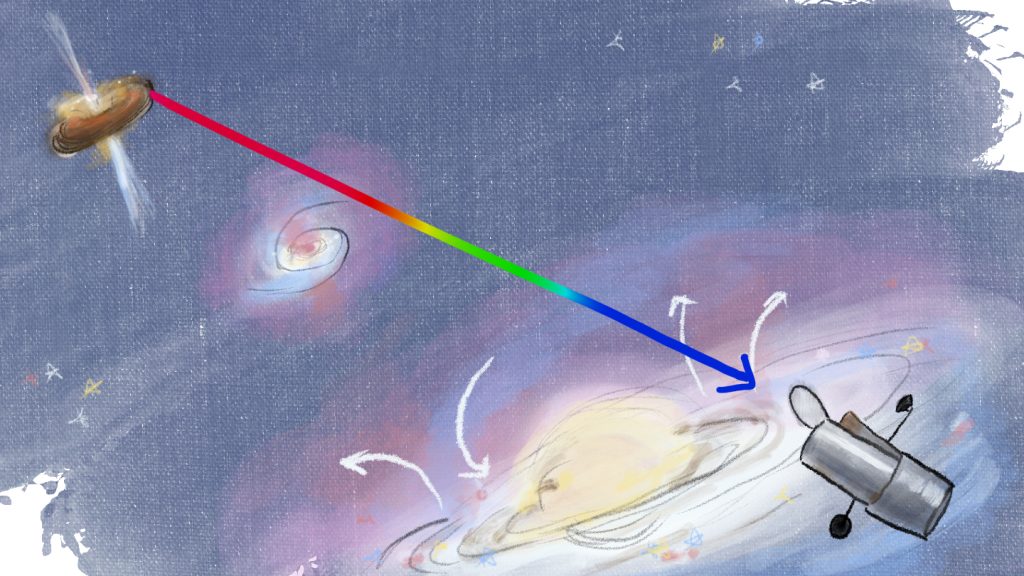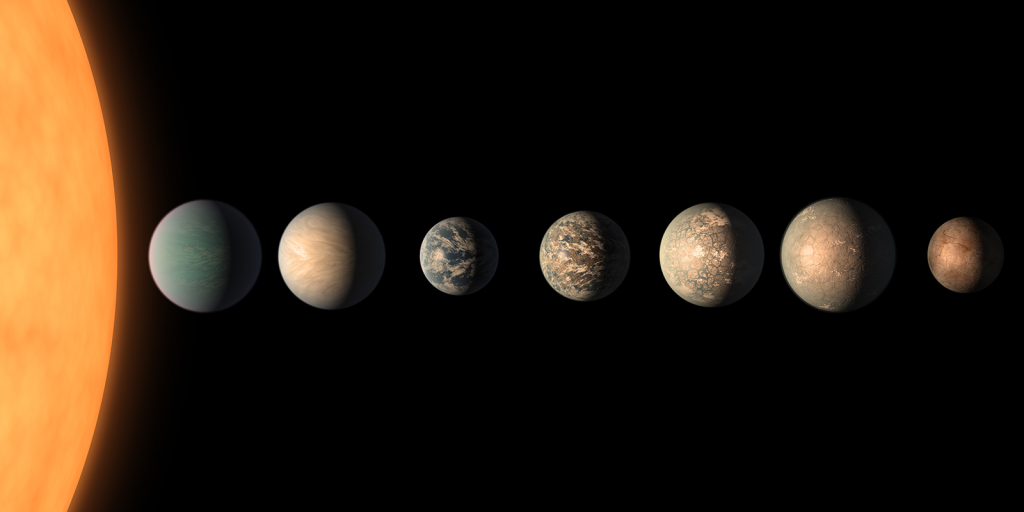Roughly half of the coursework in Pre-MAP will be spent working on a research project in a very small group with mentors from the Astronomy Department, such as graduate students, postdoctoral fellows, or faculty advisors. The research projects typically advance the research goals of your mentor, and so the projects that we offer cover a variety of topics and size-scales from stars to galaxies.
Title: A Photometric Survey of Planetary Nebulae in Southern Andromeda
Mentor: Zhuo Chen
Students: Ellis Alley
As the nearest large spiral galaxy, Andromeda offers a unique opportunity to study planetary nebulae (PNs) on a galactic scale, providing insights into galactic structure and evolution. This project aims to search the latest Hubble Space Telescope broadband imaging data to identify cataloged PNs. You will confirm or exclude the presence of PNs documented in the literature within the data footprint and subsequently measure the level of excitation in individual PNs.

Left: Search for PN source (bright, blue-green object in the small white circle) within the predicted literature position (large white circle). Right: Optical color-magnitude diagram of the PN and nearby stars.
Title: Investigating Interloping Quasar Absorption in the COS-Holes Survey
Mentor: Sam Garza
Students: Kyleigh Medard and Elli Nestlerode

Absorption-line experiments using bright background quasars (QSOs) have been recognized as an efficient way of studying diffuse gaseous atmospheres of the Milky Way and other galaxies. In this project, students will analyze HST spectra from the COS-Holes survey (a sample of nine QSOs probing the circumgalactic medium of eight galaxies) to create a catalog of quasar absorption features. Students can expect to learn about how spectra is obtained from HST, how to normalize a spectra, how to search for/identify absorption features, fit profiles to found features, and more!
Title: Dissecting the Primordial Cosmic Web
Mentor: Yakov Faerman
Students: Sophia Watts and Ishaani Purang

Observations of the very early Universe show that it started with a nearly uniform distribution of matter, with only tiny fluctuations. Today, almost 14 billion years later, we see a rich structure of galaxies, groups, and clusters organized in patterns on large scales – the cosmic web. Combining these observations with sophisticated theoretical models and large computer simulations of the cosmic web provided us with insights into the mass composition of our Universe (dark vs. regular matter), as well as into the formation and evolution of galaxies, including our own Milky Way. This is a quest that continues today, with large ground and space telescopes and increasingly detailed and complex numerical simulations.
In this project we will explore idealized simulations of isolated cosmic web structures – sheets and filaments – in the early Universe, and study the thermal properties of gas in these structures to better understand the origin of galaxies.
Title: The Stellar Flares of TRAPPIST-1
Mentors: Lupita Tovar Mendoza, Eric Agol, James R. A. Davenport
Students: Allie Lewis and Tyler Vallas
Skills: python, basic Unix commands, Jupyter notebook, numpy, pandas, matplotlib, basic github use, lightkurve package

Located about 40 light years away, TRAPPIST-1 is a famous, cold, and small M type star that is home to seven rocky exoplanets. There have been many efforts to characterize this exoplanetary system and ongoing observations seek to understand the chemical composition of the planet’s atmospheres. However, the high levels of stellar magnetic activity (e.g. flares) influence our ability to characterize the exoplanets. For this project, we will use archival Spitzer data of TRAPPIST-1 to identify and model stellar flare events. From the resulting flare samples we will be able to analyze both the flare occurrence rate and the shapes of the flares. We will also explore how the flares impact the exoplanet transits.
Title: Searching for Eclipsing Binaries in Stellar Clusters
Mentor: Tobin Wainer
Students: Amelia Ross and Danbi Kim

Eclipsing Binaries occur when two stars are orbiting each other, and from our vantage point on Earth, one star passes in from of the other. This project will try to quantify how many eclipsing binaries we can recover in star clusters, or groups are stars which are all born at the same time. By learning how many binaries form at a single time, we can better understand the processes of star formation. This project will focus on Time-Domain astronomy. Specifically, how to access and analyze light curves from the Transiting Exoplanet Survey Satellite (TESS), as well as learning to use common time-domain tools such as the frequency analysis. Students will learn what an eclipsing binary light curve looks like, and how their distinctive feature can be identified, then progress to finding eclipsing binaries in star cluster light curves.
Title: What are the drivers of periodic massive eruptions in mantle convection models?
Mentor: Rudy Garcia
Students: Samuel Stromness-Pettey

Observations of the surface of Venus appear to show that the planet may have experienced a massive, planet-wide eruption in the past billion years. Some modeling work suggests that such a massive eruption may not just happen once, but be periodic. In this project, you will run a model of mantle convection with a variety of different settings to investigate what mantle assumptions and conditions lead to massive periodic eruptions.
Title: HelioLinC Stress Testing for Near Earth Asteroid Detection
Mentor: Jake Kurlander
Students: Felix Knowlton

Asteroid discovery helps to drive planetary science, enables planetary defense, and is one of the main goals of the Vera Rubin Observatory. A new algorithm, HelioLinC, will be used to find asteroids detected in Rubin’s unique cadence. HelioLinC has been primarily evaluated in “pure” simulated settings, but real telescope data will include lots of non-solar-system objects. We will test Heliolinc’s completeness and purity as a function of “junk” data added to a real solar system simulation.
